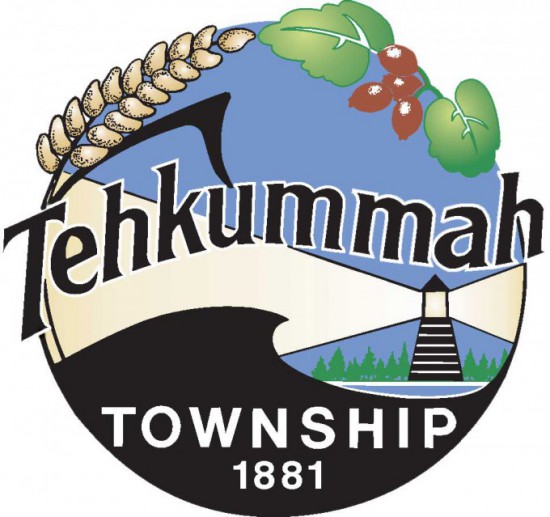TEHKUMMAH – At the March 3 meeting of council the Township of Tehkummah received a report on the Smeltzer Drain improvements from drainage contractors K. Smart Associates Limited.
Tehkummah asked K. Smart to prepare a report under Section 78 of the Drainage Act for improvements to the Smeltzer Drain on July 11, 2017. That fall, the firm did its main survey work for the watershed and the drain and designed it through the winter. There was a meeting for affected landowners in the spring of 2018.
“In 2019 the project was submitted to environmental agencies to be reviewed; we received those approvals in late November 2019, and finalized the report and submitted it,” said drainage engineer Joel Miller, who gave the presentation under the supervision of drainage superintendent John Linley.
He outlined several concerns raised by landowners at the earlier meetings. There were concerns that the drain was too wide in some places and that erosion was occurring near the Anstice/Hierons property line.
One option for the drain extension was to reroute it eastward into the Scott Drain, though there were concerns about flow and capacity so that was set aside. K. Smart also looked at using the current ditch through the centre of the McGragh property and then considered running the ditch along the western shoulder of the 10th Sideroad.
The latter option was ultimately chosen, as costs were similar between the various routes and having the drain along the road would allow for easier monitoring and maintenance.
The extra drainage work on the 10th Sideroad just north of the Sixth Concession stemmed from a roads superintendent petition from July 10, 2018 to create a ditch to help drain the water in the flood-prone area. This portion, dubbed the “Sideroad Branch” of the Smeltzer Drain, will run northward along the road, opposite Armand Charbonneau’s property, until it meets the Blue Jay Creek.
Mr. Miller said the engineers did a canoe survey on the Blue Jay Creek and made note of a rock outcrop on Lyle Gordon’s property.
“There’s no question that removing some rock here would allow more water through the creek. What we found, though, is that there was only about a 14-inch difference in the water level upstream of the rock and downstream of the rock.”
Although this is significant given how flat the creek is, the amount of time and money to get environmental approvals and work on a massive area downstream would be prohibitive. If beaver activity is managed in the drain, it should be enough to maintain the flow.
The report recommends 1,486 metres of excavation of new, open drain, cleaning out 1,951 metres of existing drains, a new 15-metre by 1,500-milimetre steel culvert at the 10th Sideroad, two new 1,500-milimetre steel access crossings and one new 1,200-milimetre steel access crossing, plus erosion and sediment control measures.
An 18-metre by 900-milimetre twinned steel culvert will cross under the 10th Sideroad and erosion and sediment control measures will be implemented. On the Blue Jay Creek itself, 1,024 metres of creek will be incorporated into the drain so beaver dams and other obstructions can be removed, and the existing 10th Sideroad culvert will be brought into the scope of the Smeltzer Drain as well.
This project serves roughly 430 hectares (1,063 acres) of land and has an estimated cost of $298,000. The work will be divided into two contracts, one for the culverts and ditching done by the road contractors in conjunction with the 10th Sideroad project and the other for drain-specific work.
Councillor Michael McKenzie said he was concerned that the Sideroad Branch wouldn’t drain because the culvert and creek water levels are so similar.
Mr. Miller said the branch will always have water present but that it will be flowing slowly downstream to the creek, even if it appears to be standing. The new culvert will be eight inches lower than the current culvert. This will not improve the current situation, but it will not make it any worse.
“We should be improving things, not just staying the same, otherwise why are we putting money into it?” asked the councillor.
Mr. Miller said the new system will allow for better control.
Councillor Eric Russell asked if the work would benefit farmers on the Smeltzer Drain.
Mr. Miller said the downstream improvements will not directly benefit the upstream farmers, but their water still needs a path to travel. They will also benefit when the upstream portion gets cleared.
Resident Paul Bowerman said he has had standing water on his land since Highway 6 was built in the area, which falls within the new Sideroad Branch’s drainage area.
“There won’t be an ounce of difference for that property because of what we’re doing, just like there won’t be an ounce of difference for (upstream properties on the Smeltzer Drain),” said Mr. Miller.
Mr. Bowerman also asked why only part of the Blue Jay Creek was being brought as part of the drain, since he understood the Blue Jay was being made into a drain as far as Mr. Gordon’s property. Mr. Miller said the Smeltzer Drain would only include a portion in this report, though the McCauley Drain extension would incorporate the rest of that portion of the Blue Jay Creek as a way of sharing the costs between drain users.
Mr. Bowerman asked why the Blue Jay Creek upstream of the 10th Sideroad was not being made into a drain. Mr. Miller said the economics of that undertaking were unreasonable.
Mr. Bowerman also asked why the cost of the Sideroad Branch was not being borne by the road project, calling it a “money catcher.” Mr. Miller said the ditch would be on the property line and the roads team would not have the authority to work on private property. Part of the cost will be borne by the road, but not all.
Pat McGragh asked if he would still be flooded on his property. Mr. Miller acknowledged that the water would be moving faster, but most of the water would be diverted along the roadside ditch. However, his own water would still flow in the existing ditch through the centre of his property.
One landowner asked how much of an improvement there will be after the project concludes. Mr. Miller said a percentage improvement could not be quantified, but said his firm undertook a cost-benefit approach and determined that the project would be worthwhile.
Council resolved to adopt the 2020 Smeltzer Drain extension report, authorized the drainage work to go ahead as specified in the report and gave Bylaw 2020-011 its first and second reading with provisional adoption on the date of the council meeting.
Section 97 of the Drainage Act requires that the township convene a three-member court of revision for the project. Council also authorized the clerk-administrator to identify three members to act as the court members and set the date for the court on April 7, before the next council meeting, at 5 pm. After the end of the meeting, the councillors remained at the table for a time with clerk-administrator Silvio Berti to discuss the court of revision.




